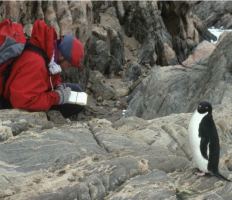Coastal and marine
Coasts form a dynamic, transition zone between the land and the sea. Australia's coastline is one of the longest in the world. Furthermore, as an island continent, Australia has rights over a vast area of ocean, along with the resources found in these areas. Australia also has responsibly for parts of Antarctica and the surrounding ocean. The Australian Antarctic Territory covers nearly 5.9 million square kilometres, about 42% of Antarctica and a marine jurisdiction extending over an area of approximately 2.2 million km2.
Teacher Guides and Resources

The Australian Coast - Teacher notes and student activities
Australia's coastline is one of the longest national coastlines in the world. This booklet provides information about the major physical environmental characteristics of the Australian coast and the major physical processes which shape the coast as well as an introduction to the human-induced processes which impact upon Australia's coast. Student activities are included.

Australia’s Maritime Jurisdiction - Teacher notes and student activities
This booklet contains information about the law of the sea. It explains how maritime zones are decided, the continental shelf and economic exclusion zone, and managing Australia's jurisdiction.

Sea floor and land topography of Australia and surrounding region
This poster depicts the land and seafloor topography of Australia and its surrounds. It highlights many dramatic seafloor features associated with the continental margin and ocean basins around Australia and its external territories.

Australia's Maritime Jurisdiction around Australia map
Map showing Australia's Maritime Jurisdiction around the Australian Continent, not including Cocos Island, subantarctic territories or the Australian Antarctic Territory.

Australia's Maritime Jurisdiction map
Map showing all of Australia's Maritime Jurisdiction including external Territories and the Australian Antarctic Territory.

Weathering, erosion, landforms and regolith - Teacher notes and student activities
This booklet focuses on the processes of weathering and erosion, and includes case studies on Australian landforms such as Uluru, the Warrumbungles and the Twelve Apostles.

Poster featuring satellite image of Antarctica and geological history of the continent.
Student Activities

Explore sonar and bathymetry with bouncy balls and pre-prepared data.

Antarctic Geoheritage (primary and secondary)
Get a taste for what it was like for scientists living in Antarctica with this code breaker activity.

What lies beneath the Antarctic Ice?
Discover what scientists found beneath the ice of the Amery Ice Shelf in eastern Antarctica by examining organisms found in ice cores.
Videos
Bathymetry of Australia
This video is a flythrough around the coast of Australia shows the major topographic features of the seafloor around the continent. Starting in the south west the viewer can see the continental shelf and slope of the southern coast followed by the seamount chains and the Great Barrier Reef to the east. Continuing around the north then west coast the eastern end of the Java Trench is shown before returning to Perth and pulling out to show the whole continent.
Fossil shell stories
Fossil shells can tell us about past environments. This video presents examples of shell fossils that help us to understand where oceans were located in Australia millions of years ago. Brachiopods from Canberra and a large spiral shell from the Nullarbor Plain are showcased.
Virtual Exhibits

The history of Geoscience Australia activities in Antarctica
Further information

Range of Geoscience Australia’s geospatial services/maps which include water, coastal and marine.

Australia's Coasts and Estuaries
Information on Australia’s coasts and estuaries and management of these locations.

Australia's Marine Jurisdiction
Information on terminology and language around marine jurisdictions, Australia’s marine jurisdiction, Law of the Sea and marine maps.

OzCoasts - Australian Online Coastal Information website
OzCoasts provides comprehensive information about Australia's coast, including its estuaries, coastal waterways and climate change impact.

Shaping a Nation: A geology of Australia book
Exploring the geology, resources and landscapes of Australia, this comprehensive book reveals how these have helped to shape this nation's society, environment and wealth. Chapter 6 is all about the coastal zone.

Dimensions and areas of Australia’s oceans and seas, continental extremities, border lengths and offshore territories.
Australian Curriculum links
Year 4
Science > Science Understanding > Earth and Space Science > Earth’s surface changes over time as a result of natural processes and human activity (ACSSU075)
Year 7
Science > Science Understanding > Earth and Space Science > Some of Earth’s resources are renewable, including water that cycles through the environment, but others are non-renewable (ACSSU116)
Geography > Geographical Knowledge and Understanding > Unit 1: Water in the World > Classification of environmental resources and the forms that water takes as a resource (ACHGK037) > The quantity and variability of Australia’s water resources compared with other continents (ACHGK039)
Year 8
Geography > Geographical Knowledge and Understanding > Unit 1: Landforms and Landscapes > Different types of landscapes and their distinctive landform features (ACHGK048)
Senior Secondary
Earth and Environmental Science > Unit 1: Introduction to Earth systems > Water’s unique properties, including its boiling point, density in solid and liquid phase, surface tension and its ability to act a solvent, and its abundance at the surface of Earth make it an important component of Earth system processes (for example, precipitation, ice sheet formation, evapotranspiration, solution of salts) (ACSES024)
Legal studies > see your states/territory curriculum.





